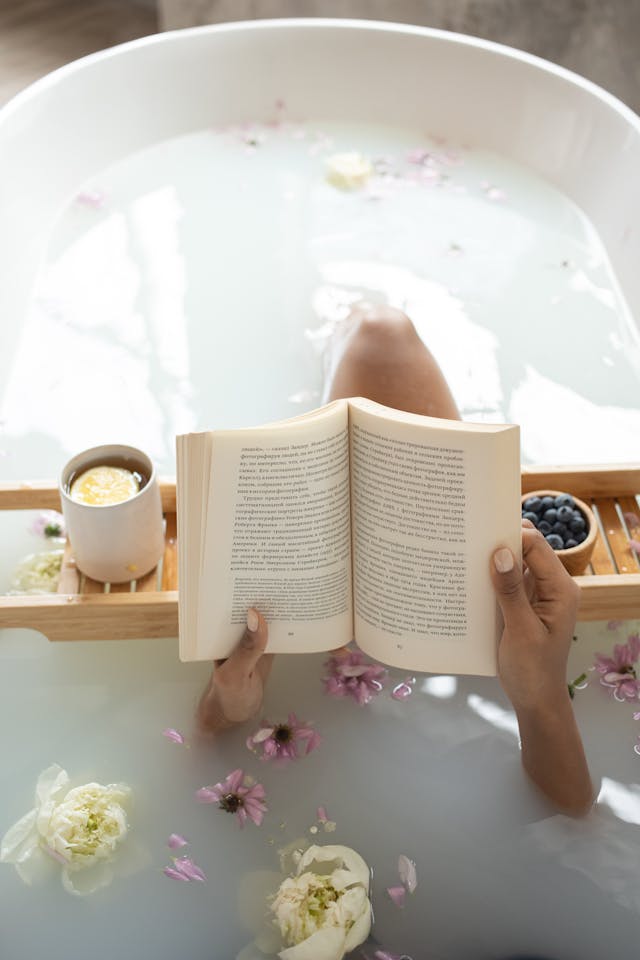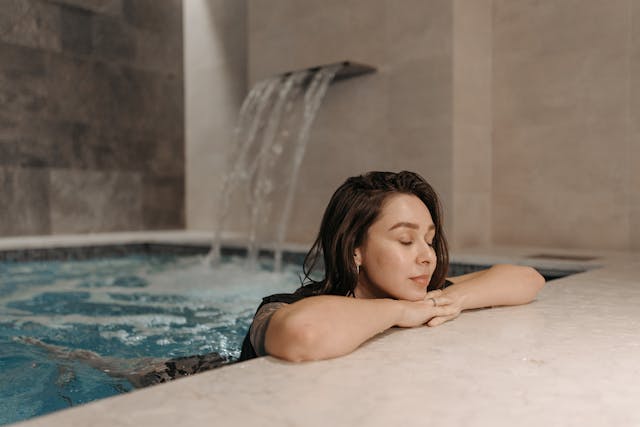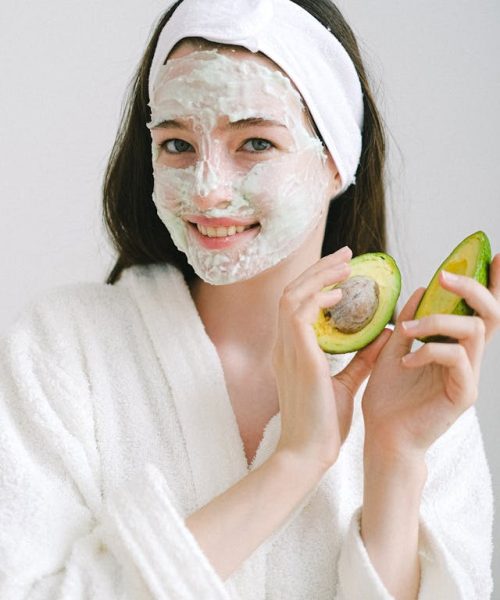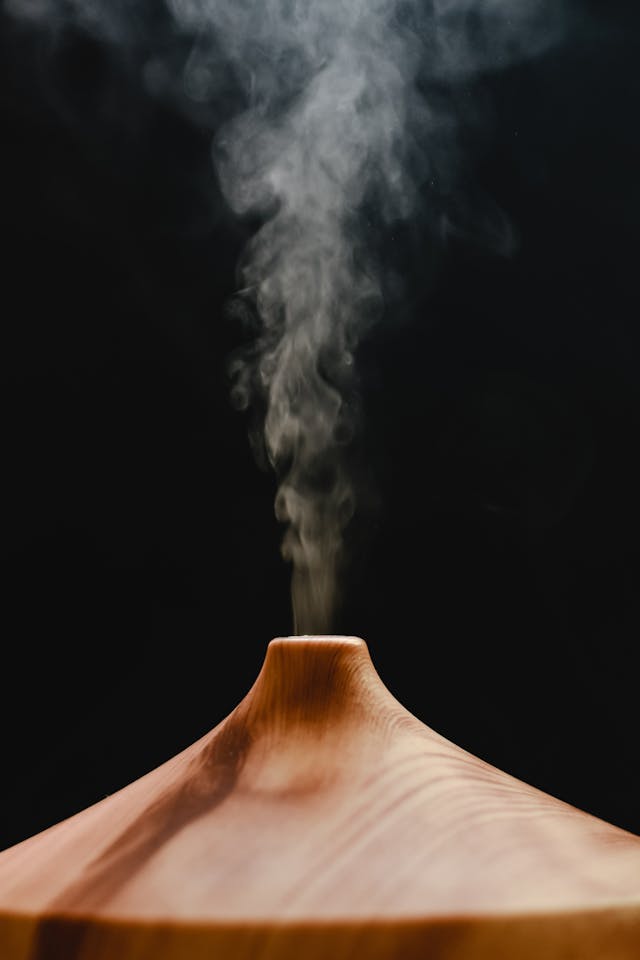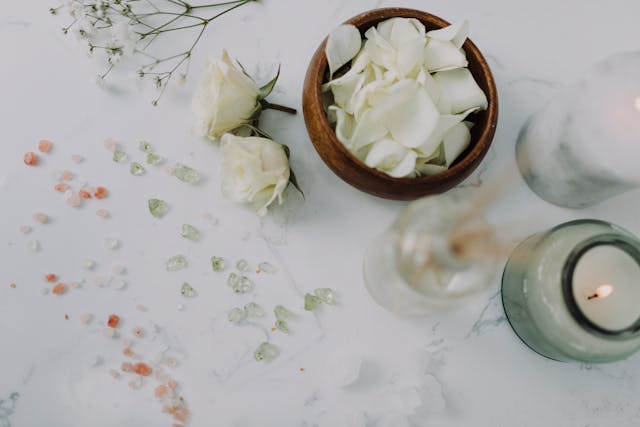
DIY Home Spa Day: Tips for Relaxation and Rejuvenation
The need for a home spa is something every person has in today’s fast-paced lifestyle. Transforming your house into an oasis is not as difficult as it may seem. It is even better that the home spa can be customized as per your requirements. You choose the atmosphere, the mood and even the ingredients for your spa! In this guide, I will provide all the techniques, recipes and rituals that will help in turning your bathroom from ordinary to a wellness sanctuary. Not only is your mental and physical health important, the spa will ensure long-lasting benefits.
Setting up a spa day at home offers a holistic approach to well-being. The ordinary stress in today’s modern lifestyle harms skin and sleeping patterns. Dedicating some hours, or even a full day, to yourself is not a luxurious act. Science suggests the numerous benefits relaxation provides us with. With so much to lose, isn’t it time to tackle the stress somewhere? Relaxing lowers the stress hormone cortisol, enabling better sleep and fortifying the immune system. In this guide, I shall strive to create all the experiences without you having to leave your home.
Preparing the Environment for Your Spa Day at Home
The first secret to a successful spa day at home lies in environmental preparation. Professional spas invest thousands in sensory design because they know the environment is fundamental to the relaxation experience. Start by turning off electronic devices and notifying family members about your sacred self-care time. Organize the space, removing household items that remind you of pending tasks – bills to pay, laundry to wash, or unfinished work are incompatible with your relaxation sanctuary. The goal is to create a temporary bubble where obligations and worries cannot penetrate.
Lighting plays a crucial role in your spa day at home. Replace bright fluorescent lights with softer alternatives – beeswax candles, string lights, or lamps with warm yellow bulbs. Candles not only provide ideal lighting but can also bring aromatic benefits when chosen with essential oils like lavender, peppermint, or eucalyptus. Room temperature also deserves attention: studies show our bodies relax better in slightly warmed environments, between 73-77°F (23-25°C). On cold days, a portable heater can work wonders; on hot days, consider a gentle fan that won’t disturb your experience.
Sensory decoration complements your home relaxation experience. Soft fabrics like Egyptian towels, plush robes, and velvet cushions create pleasant tactile sensations. Plants like lavender, rosemary, and jasmine not only decorate but purify the air and add natural aromas. An organized tray with your spa products, some fresh flowers in a small vase, and perhaps a bowl with water and floating petals can instantly transform the environment. Ambient sound is also essential – playlists of nature sounds, soft instrumental music, or meditative mantras can be found free on streaming platforms, completing the multisensory atmosphere of your wellness refuge.
Hydrotherapy Rituals: The Transformative Power of Water
Water is the most important component for any at home spa day. Sp@ By Soul features a special article about the experience of thermal baths synchronized with lights and sounds, where, without a doubt, water plays the leading role From Japans to Romans, ancients understood how to heal using water and already developed complex bathing rituals with therapeutic methods. Calmly putting your body in warm water will switch on the parasympathetic system: a state responsible for “rest and digest.” It reduces the heart rate as well as enables relaxation. Muscle pain relief, improved blood circulation as well as enhanced subsequent treatment absorption could be achieved with warm immersion baths relaxation achieved through warm water immersion.
It would be wise to consider adding some therapeutic elements so that the immersion bath is enhanced during spa days planned at home. Magnesium is easily absorbed through skin, and this is why Epsom salt is a classic. They also ease inflammation and relax tense muscles. For baking soda, it softens skin, decrease irritations, and alkalizes water. Moreover, some skin specific essential oils can be added such as lavender for relaxation, eucalyptus for easing respiratory congestion, rosemary for increased alertness or ylang-ylang for balance. Ylang-ylang adds balance. Do not forget to mix essential oils with a tablespoon of coconut oil to avert skin irritation.
If you don’t have a bathtub, hydrotherapy treatments can be adapted to your needs. Foot baths are astonishingly effective considering the number of nerve endings in our feet that are associated with different organs. Submerging your feet in warm water and slowly increasing the hot water will improve body circulation that is stimulated by the foot bath. Place some smooth stones at the bottom of the basin for massaging foot pressure points. The towels can also be heated and soaked in water with calming aromatic herbs such as chamomile, mint, or rosemary, and placed on the neck, shoulder, or back for relaxation without immersion.
Exfoliation and Face Masks: Secrets for Radiant Skin
Cellular renewal is a crucial component of any effective spa day at home. Our skin is constantly renewing cells, but factors like stress, pollution, and age can slow this process, resulting in a dull appearance and irregular texture. Conscious exfoliation removes dead cells, stimulates blood circulation, and prepares skin to better absorb ingredients from subsequent treatments. Unlike commercial products often loaded with microplastics and harsh chemicals, homemade exfoliants allow complete control over ingredients, adapting them to your skin’s specific needs.
For a rejuvenating body scrub, combine 1/2 cup brown sugar (gentler than white) with 1/4 cup coconut oil and 10 drops of your preferred essential oil. The ratio can be adjusted to achieve desired consistency. For sensitive skin, replace sugar with ground oatmeal. Apply with gentle circular motions, always in the direction of venous circulation (toward the heart). Areas with thicker skin like elbows, knees, and heels benefit from extra attention. Remember: exfoliation shouldn’t cause discomfort – excessive pressure or overly abrasive ingredients can damage the skin barrier and cause more harm than good.
Face masks are the crown jewels of your spa day at home – they not only deliver beneficial ingredients to the skin but force a moment of complete stillness and mindful attention. For dry skin, a hydrating mask with 1 tablespoon ripe avocado, 1 tablespoon raw honey, and a few drops of almond oil deeply nourishes. Oily skin benefits from a balancing mask with 1 tablespoon green clay, a few drops of rose water, and 1/2 teaspoon honey. Sensitive and reactive skin loves the simplicity of a calming mask with 2 tablespoons plain Greek yogurt and 1 tablespoon grated cucumber. The ideal frequency for intensive masks is 1-2 times per week – excess can overwhelm skin and cause irritation. During application, take the opportunity to perform facial self-massage, stimulating acupressure points that help release tension in facial muscles.
Aromatherapy: Enhancing Your Spa Day With Soothing Scents
One of the most special elements of a home spa day is the experience of essential oils. Aromatherapy is one of the quintessences of Sp@ By Soul. You can read a full article on the convergence between essential oils and rejuvenation. There’s also a very special article about essential oils in the Holy Scriptures.
During a spa day at home, a aromatherapy is more than just nice fragrances; it is an age-old healing method combining essential oils from different plants to enhance one’s emotional and physical wellbeing. For example, during a spa day at home, the right smells can either relax your mind, much like a soothing melody, or enliven you much like an upbeat tune. The fragrances that we breathe have a direct effect on the limbic system of the brain—the part that deals with emotions and memories. There are many reasons as to why people use certain scents to bring back memories or change their emotional state. The good news is that we can use this phenomenon strategically during spa days for self-care.
To use aromatherapy on your spa day at home, there are many ways to diffuse essential oils. Ultrasonic diffusers are more advanced as they produce fine mist of essential oils and do not harm the oils therapeutic properties. Basic methods include using oil and water in a spray bottle to create an aroma mist, cotton pads placed around the relaxation area, or diffuser jewelry.
Recommended essential oils for relaxation are lavender which reduces anxiety and promotes sleep, Roman chamomile which calms the nervous system, bergamot which relieves stress without drowsiness, and sandalwood which promotes clarity during meditation.
To maximize the advantages of scents while taking care of yourself, consider trying the aromatic “facial steam bath.” Place a basin filled with hot water in front of you and add 3-5 drops of eucalyptus, pine, or tea tree essential oils. Next, cover your head loosely with a towel, creating a tent over the basin, and inhale the steam deeply for 5-10 minutes. This technique facilitates deep inhalation while also opening pores, moisturising the skin, and easing muscle tension. If opening the eyes, please use protective goggles to avoid irritation and watch out for steam burns while maintaining a safe distance from the steam source. Reverberate them with a hint of chilly compress on the temples and they are refreshing and activating all the senses.
Massage and Self-Massage Techniques for Muscle Relief
Including massage in your spa day at home offers benefits that go far beyond momentary pleasure. From a physiological perspective, precise muscle tissue manipulations increase blood flow, eliminate accumulated toxins, reduce chronic tension, and improve range of motion. From a psychological perspective, therapeutic touch releases oxytocin and serotonin – neurotransmitters responsible for feelings of well-being and connection. While nothing replaces the experienced hands of a professional massage therapist, well-executed self-massage techniques can provide significant relief and perfectly complement your home spa experience.
To enhance your home massage experience, start with an appropriate oil. Carrier oils like sweet almond, jojoba, or grapeseed provide ideal glide without clogging pores. Warm a small amount between palms before application and consider adding 2-3 drops of relaxing essential oils per tablespoon of base oil. Simple tools can elevate your self-massage: tennis balls to press tense points against a wall, foam rollers to release fascia in back and legs, or even a pair of socks with marbles inside to massage feet. The key to effective self-massage lies in moderate pressure – strong enough to reach deep tissues, but not to the point of causing pain.
Areas deserving special attention during your spa day at home include the scalp, often neglected but full of nerve endings. A 5-minute cranial massage with circular movements of fingertips can relieve tension headaches and promote deep relaxation. The face accumulates tension in specific points: temples, jawline, and space between eyebrows. Use middle fingers to apply gentle pressure and circular movements in these areas. For hands tired from typing, a homemade paraffin bath (wax melted at safe temperature) followed by self-massage between fingers and around joints can restore mobility and relieve discomfort. Always remember: massage should be a pleasurable experience – intense pain, tingling, or numbness are signs to reduce intensity immediately.
Nutrition and Hydration: Nourishing Your Spa Day at Home from Within
The complete spa day at home experience should nourish not only externally but internally as well. Luxury spas worldwide have long understood that proper nutrition amplifies the benefits of external treatments. During your self-care day, foods and beverages become part of the therapeutic ritual, not just sustenance. Adequate hydration, for example, enhances the elimination of toxins mobilized during massages and thermal treatments, while certain nutrients can calm internal inflammation that often manifests as skin problems. Consider your spa menu as delicious preventive medicine – an opportunity to provide exactly what your body needs for cellular regeneration and biochemical balance.
For your personalized spa menu, prioritize anti-inflammatory, hydrating, and antioxidant-rich foods. Naturally flavored waters with cucumber, mint, lemon, or red berries transform simple hydration into sensory experience, while providing essential vitamins and minerals. Herbal teas like chamomile, lavender, and valerian complement the relaxing effects of external treatments, while ginger, mint, and green tea offer energizing properties when the goal is revitalization. Avoid alcohol, caffeine, and refined sugars that can cause spikes followed by energy crashes, compromising your deep relaxation experience.
For snacks during your spa day at home, prepare options in advance that won’t compromise your relaxation state. Smoothies with spinach, avocado, banana, and chia seeds offer essential nutrients for cellular regeneration in easily digestible format. Cut fruits arranged aesthetically on a beautiful tray add visual element while providing antioxidants. Activated almonds and nuts (soaked for 8 hours to neutralize antinutrients) are rich in magnesium – the relaxation mineral. Hummus with colorful vegetable sticks, homemade energy bars based on dates, or avocado lightly seasoned with lemon and sea salt flakes are options that sustain stable energy without overloading the digestive system, allowing your body to direct energy toward regenerative processes instead of heavy digestion.
Mindfulness and Meditation - The Cognitive Aspect of Your Spa Day
n all-encompassing spa experience at home includes taking care of the mind. Chronic or constant stress is not mere wordplay. Stress produces real-life biochemical cascades that are harmful to our cellular processes. This accelerates aging and compromises our immunity as well. Meditative practices, breathing techniques, guided visualization – all serve to break the cycle of negative stress responses and facilitate relaxation. Neuroimaging studies have shown that just 8 minutes of concentrated meditation can decrease activity in anxiety-prone areas of the brain and enhance functioning in areas responsible for emotional control and attention focus.
Pairing meditation practices into your spa day at home is ideal for beginners because one can already be at home in a soothing enviorment. Therefore, start with simple breathing exercises – inhale while counting to 4, hold for 2, exhale counting up to six. This 4-2-6 ratio automatically triggers a breathing response known as the parasympathetic nervous system. Following the calming breaths, you may try a body scan meditation, paying attention to any sensations from your head down to your feet, notice what you feel without judging it. Those who prefer more structure might find guided relaxation deep meditation sessions useful, offering numerous time options ranging from minutes to hours. The key is in the consistency, not the time frame. Five minutes undistracted is far more helpful than twenty minutes of half-hearted distraction.
Creative visualization goes especially well with your home wellness ritual. Structured imagination is used to elicit vivid mental images that evoke real sensory experiences, and in turn, remarkable physiological responses. Picture yourself in a peaceful, safe place, such as a deserted beach, calm forest, or a private garden—all while comfortably lying down. Engage all your senses: listen to the waves or chirping birds, feel the warmth of the sun or a soothing breeze, see bright colors, and smell different scents. Regular visualization has been proven to fortify the neural pathways tied to emotions and bolster resilience. To get the best results, record a detailed description of your “safe place” with proper pauses so that the listener may fully immerse themselves without worrying about what is coming next.
Creating Your Personalized Spa Day at Home Kit
Advance planning is essential for an uninterrupted spa day at home experience. The act of carefully preparing your kit already begins the process of disconnecting from daily worries, signaling to mind and body that sacred self-care time approaches. Unlike commercial products with questionable preservatives, your artisanal creations will have limited shelf life – generally between one and two weeks when properly refrigerated. Amber or dark blue glass protects preparations with essential oils from light degradation, while airtight containers prevent contamination. Clearly label each item with contents and preparation date, transforming functional aspects into aesthetic elements that enrich your visual experience.
For a complete basic spa day at home kit, consider preparing: body scrub in airtight jar; fresh face mask in small container; aromatherapy room spray; massage oil in dropper bottle; therapeutic bath salts in decorative glass; herb sachets for infusion (chamomile, lavender, lemon balm); floral water in spray bottle for refreshing during the day; nourishing lip balm; and whipped body butter for post-treatment hydration. Non-consumable complements include: essential oil diffuser or natural candles; soft towels dedicated exclusively to spa rituals; eye pillow with flax seeds or lavender; natural bristle brush for dry brushing; massage ball or roller; headband to keep hair away during facial treatments; pre-selected playlist; and a specific journal to record your experiences and adjustments for future sessions.
Sustainability can and should be part of your wellness ritual. Opt for local organic ingredients whenever possible – not only for their superior nutritional benefits but for their reduced environmental impact. Reuse glass bottles and jars, giving new life to packages through proper cleaning and sterilization. Replace disposable cotton pads with washable fabric discs made from bamboo or organic cotton. Natural loofahs grown without pesticides offer biodegradable exfoliation. Consider waste from your treatments – fruit peels used in face masks can be composted, creating a virtuous cycle where your beauty rituals literally nourish new growth. This conscious approach adds an ethical dimension to your spa day, aligning personal well-being with planetary responsibility.
Adding Home Spa Practices in Daily Life Activities
Though a home spa day may sound exhilarating, true transformation happens when those practices are integrated into one’s day to day activities. At least in my experience, the secret lies in identifying self-care micro-moments that can be squeezed in even on the busiest days, in stress accumulation prevention anchors. These self-care moments, done consistently, lead to marked improvements in both physical and mental health. Studies of habits show that small, regular changes are much more successful for lasting behavioral shift than infrequent radical adjustments. Think of your complete home spa day as a boot camp that gives you many tools and techniques, but daily practice is where the magic happens.
Spa-level self-care does not need to take up much extra time, as it can easily be worked into morning rituals. Dry brushing for three minutes before steping into the shower helps to encourage the circulation of the lymphatic system and the cleansing of toxins. Alternating between hot and cold water showers (ending with cold) for thirty seconds each is energizing to both the body and mind and does wonders comparable to professional hydrotherapy. Putting body oil on skin post shower while still damp ensures pores are fully opened and airtight sealing moisture happens with the least amount of product used. Applying a skincare’s facial treatment device for one minute ensures essential ingredient absorption. Inhale deeply while on the road, which turns travel time into a calming rest for your nervous system. The important point is mindfulness – even habitual motions like washing a face or applying moisturizer turn into therapeutic activities when accompanied with presence and attention.
To make integrated self-care reminders more comprehensive, try intertwining new self-care techniques with already existing habits. During shower, a face massage stone can be picked up from the shelf in order to multitask while waiting for the conditioner to do its magic. Essential relaxation oil can be placed beside the toothbrush to function as a prompt for deep breathing exercises during brushing the teeth in the evening. Schedule silent reminder at the afternoon for a three-minute break dedicated solely for stretching and drinking water. Turning tension relief exercises into a self care ritual involves applying lavender pillow spray, self-foot massage with mentholated cream, and gentle soothing stretches to feel release from the body’s build up of tension. Recording subjective feelings and benefits within a dedicated self-care journal fosters a stronger awareness to these practices. Don’t forget that maintaining consistency is always more helpful than setting overly intense goals. Spending five minutes a day to perform simple self-care can add to over 30 hours of restorative practices over a year which is more than enough to improve one’s overall well-being.
Enjoying this content? You’ll love this one too:

The Spiritual Significance
of Essential Oils in the Bible.
Frequently Asked Questions about Spa Day at Home
How often should I perform a complete spa day at home?
For optimal results, reserve one complete day monthly for deep immersion in self-care practices. Additionally, shorter weekly sessions of 1-2 hours maintain benefits between more intensive experiences. The key is observing signals your body offers – increased irritability, persistent muscle tension, or sleep difficulties often indicate need for more frequent regenerative breaks.
How do I adapt spa activities for different seasons?
In summer, prioritize refreshing treatments: cucumber and yogurt masks, mentholated body sprays, and warm baths with citrus oils. Winter calls for intensive nourishment: denser body oils, face masks rich in plant butters, and hot baths with warming essential oils like cinnamon and ginger. Spring favors gentle detoxification: renewing exfoliations, purifying herbal infusions, and floral aromas. Autumn benefits from grounding practices: firm pressure massages, woody essential oils, and treatments focused on reflexology.
How can I create a spa day at home on a limited budget?
Pantry ingredients like oats, honey, yogurt, coffee, and sea salt form excellent base for effective treatments. Essential oils, while initially more expensive, yield hundreds of applications when used properly. Invest in one or two versatile oils like lavender and peppermint. Replace electric diffusers with traditional method of adding drops to boiling water. Old towels can be transformed into turbans and compresses. Empty sterilized bottles and jars substitute specialized packaging. Remember: the most transformative element—mindful attention—is completely free.
How do I handle interruptions during my spa day at home?
Clearly communicate the importance of this time to family members and establish loving but firm boundaries. Put phone on airplane mode or silent, with automatic message informing temporary unavailability. For homes with small children, consider rotating with partner or shorter sessions during naps. Have flexible expectations—if interrupted, breathe deeply and consciously return to relaxed state when possible, instead of completely abandoning the experience.
Can I perform spa day at home with skin problems like eczema or rosacea?
Absolutely, but with careful adaptations. Avoid mechanical exfoliation on sensitized areas, opting for gentle enzymatic alternatives. Replace potentially irritating essential oils with hydrolats (floral waters). Prioritize calming ingredients like colloidal oats, chamomile, and calendula. Perform 24-hour contact test before using new products. Extreme temperatures can exacerbate inflammatory conditions, so keep water and compresses warm instead of hot. Consult dermatologist for personalized recommendations according to your specific condition.
Concluding Your Day of Transformation
Creating a spa day at home goes far beyond simple indulgence – it represents conscious commitment to your integral health in a world that often normalizes chronic exhaustion. Benefits extend far beyond dedicated hours, manifesting in more radiant skin, more relaxed muscles, deeper sleep, and greater emotional resilience facing daily challenges. As we’ve seen, this practice doesn’t require exorbitant investments or dedicated spaces – just intentionality, some simple ingredients, and willingness to genuinely slow down. The beauty of home self-care lies in infinite personalization – over time, you’ll discover unique combinations of aromas, textures, and rituals that resonate perfectly with your specific needs.
When concluding your spa day at home, reserve a few minutes for conscious integration. Sit comfortably and mentally scan your body, noting differences in tension levels, breathing quality, and mental clarity compared to the beginning of the experience. Record discoveries, successful combinations, and adjustments for future sessions in a journal. This reflective moment not only solidifies immediate benefits but transforms your spa day into an evolutionary process that continuously improves.


Stay Inspired – Join Our Inner Circle!
Subscribe to our newsletter for exclusive tips, soulful stories, product finds, and early access to new blog posts + freebies!

